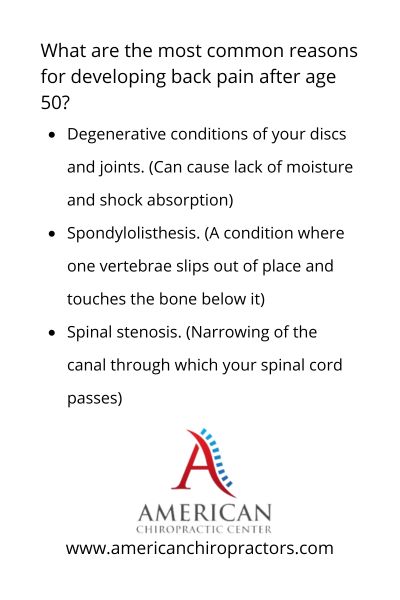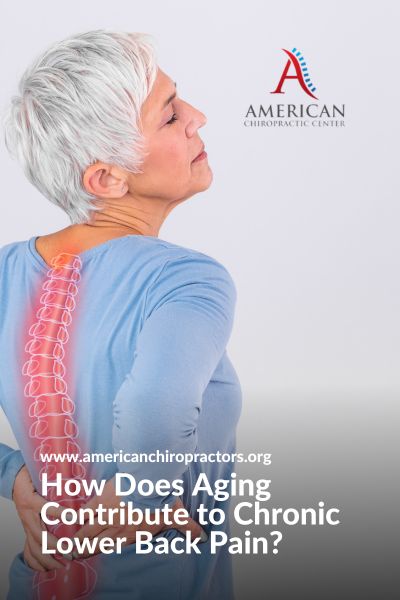Back Pain
How Does Aging Contribute to Chronic Lower Back Pain?

The familiar twinge in your lower back. A sensation that establishes itself more firmly with each passing year. But have you ever stopped to wonder why? How does aging contribute to chronic lower back pain?
Understanding the link between age-related wear and tear and ongoing aches is not just about curiosity. It’s about more than that. It’s about unlocking the knowledge to manage your discomfort well. It’s also about reclaiming the quality of life that nagging pain tries to steal.
Read more about How Does Aging Contribute to Chronic Lower Back Pain

Let’s examine the fascinating yet sometimes frustrating ways our bodies change as we age. These changes make us more prone to back troubles.
More about How Does Aging Contribute to Chronic Lower Back Pain

Understanding Lower Back Pain
Consider your lower back’s complex muscles, ligaments, and nerve networks. Understand the causes of back pain, especially in the adult population. It is incredibly important for managing and preventing discomfort. Studies with a large sample size may find that certain factors are common culprits in low back pain.
Back pain from aging can come from spinal stenosis. This is where the spinal canal narrows and puts pressure on the spinal cord and nerves. The discs between the vertebrae break down with age. This causes degenerative disc disease, like other common conditions. It leads to pain and reduced flexibility.
Studies show these conditions can contribute to chronic lower back pain as you age. Recognize these risk factors. Take proactive steps to reduce symptoms. Do this for a healthier back. It’s part of your well-being routine.
Common Causes of Lower Back Pain
Musculoskeletal pain, often age-related, is a common cause of back pain as you get older. Over time, wear and tear on your muscles, ligaments, and joints can cause pain and stiffness in the lower back, which can lead to significant pain.
Vertebral fractures can result from conditions like osteoporosis. They are another common cause of lower back pain, especially in older patients. These fractures can cause sharp pain and limit your mobility.
Aging and the Human Body
The aging process causes a decline in the musculoskeletal system. Bones weaken, muscles lose mass, and joints stiffen. These changes make the body prone to injuries, pain, and chronic conditions. They especially affect the lower back. Analysis of the aging process is key to understanding how to mitigate age-related back problems.
The Aging Process: An Overview
The aging process impacts your body in many ways. This leads to changes in physical capabilities and health. The risk of age-related back pain increases as you age, especially in the lumbar spine region. Wear and tear on the spines over the years can cause conditions. These include degenerative disc disease, spinal stenosis, and osteoarthritis. These conditions lead to discomfort and stiffness in the lower back.
Spinal cord injuries become more common with age. They affect mobility and make chronic lower back pain more likely. Understanding how aging affects your body can help you take proactive measures. These measures can maintain spinal health and reduce age-related back problems.
How Aging Affects the Musculoskeletal System
Aging affects the musculoskeletal system. It changes bone density, muscle mass, and joint flexibility. These changes can directly cause lower back pain. Understanding the source of these changes is important to prevent and address pain.
As you age, your bones become less dense and more prone to fractures. This decrease in bone density can lead to conditions like osteoporosis. It makes your vertebrae weaker and more prone to injuries.
Muscle mass tends to decrease with age. This weakens spine support and raises the risk of straining lower back muscles.
Joint flexibility decreases over time. This reduces your range of motion and may cause stiffness and discomfort in the lower back.
Aging and Lower Back Pain
Your spine changes as you age. This includes disc degeneration, reduced bone density, and muscle loss. These factors make you more susceptible to lower back pain. Specific issues include herniated discs, compression fractures, and weak muscles that strain your back.
The Correlation Between Aging and Lower Back Pain
This link is often due to age-related changes in the spine. These changes include lumbar spinal stenosis and degeneration of facet joints.
As you grow older, the discs between the vertebrae tend to lose water content and elasticity. This leads to decreased disc height and potential nerve compression. The facet joints may undergo wear and tear, causing pain and reduced mobility.
It’s best to consult a spine specialist for proper evaluation and management. Do so if persistent lower back pain starts as you age.
Specific Age-Related Changes That Lead to Lower Back Pain
You may notice that specific age-related changes in your spine can directly contribute to the development of lower back pain. These changes include:
- Degeneration of the Spine: The discs between your vertebrae lose water and stretch over time. This reduces disc height and flexibility. This can lead to back or neck pain. It can also cause tingling, weakness, and severe pain. Plus, it can lead to a decrease in feeling in your legs and numbness.
- Compression Fractures: Aging weakens the bones in the spine. This makes them more prone to compression fractures. These fractures cause pain and reduce mobility. These fractures are often associated with unexplained weight loss.
- Herniated Discs: As you age, the discs in your spine may become more likely to bulge or herniate. This puts pressure on nearby nerves and causes back pain. This can also lead to radiating pain or leg pain.
- Loss of Muscle Mass: Aging reduces muscle mass and strength. This leads to poor posture and increased strain on the lower back.
Chronic Lower Back Pain
Chronic lower back pain is a persistent condition that can greatly impact daily life. Understanding its definition and characteristics is vital for managing its effects. Addressing the root causes is important. This is because acute pain shifts to chronic.
Definition and Characteristics of Chronic Lower Back Pain
Chronic back pain often comes from problems in the intervertebral discs or spinal canal narrowing. These issues cause ongoing discomfort and less mobility.
Acute back pain resolves within a few weeks. But, chronic lower back pain persists for at least 12 weeks. Individuals with chronic back pain may experience stiffness, sharp pain, or dull aches. These issues limit their daily activities. This pain can hurt the quality of life. It affects one’s ability to work, exercise, and do hobbies.
Getting the right medical care is important. So is making lifestyle changes. They are key to managing chronic lower back pain well.
The Transition from Acute to Chronic Lower Back Pain
The shift from acute to chronic lower back pain typically occurs when the initial injury or condition isn’t adequately addressed or healed.
Acute lower back pain is often triggered by sudden movements or injuries. It is usually temporary and goes away in a few weeks with proper treatment. But, if the underlying cause isn’t effectively treated or if the pain is ignored, it can progress into a chronic condition.
Effective management strategies prevent this change and ease chronic lower back pain. They include physical therapy, lifestyle adjustments, and medication.
Age-Related Conditions That Cause Lower Back Pain
As you age, conditions like osteoarthritis, spinal stenosis, degenerative disc disease, and spondylolisthesis can contribute to lower back pain. These age-related issues may cause pain, stiffness, and less mobility in your lower back. Knowing how these conditions affect your spine can help you manage the discomfort of aging.
Osteoarthritis
As you age, the cartilage that cushions your joints may wear down. This wear down leads to osteoarthritis. This can result in stiffness, pain, and a decreased range of motion in the lower back.
Osteoarthritis causes cartilage to break down in the spine’s facet joints. This leads to bone-on-bone contact and inflammation. This degenerative process can cause chronic lower back pain. It happens as the nerves become irritated and the spine’s structure weakens. Over time, osteoarthritis causes wear and tear. This can worsen discomfort, making it difficult to do daily activities.
Managing osteoarthritis requires exercise, proper posture, and medical care. These can help reduce lower back pain from this condition.
Spinal Stenosis
As you age, the spaces in your spine may narrow. This puts pressure on the nerves that travel through the spinal canal. This compression can cause chronic back pain. It can also cause leg pain, numbness, or weakness that radiates down the legs. Studies often explore the association between stenosis and back pain.
Symptoms of spinal stenosis can get worse over time. To manage this condition, doctors may recommend treatments. These include physical therapy and medications. In severe cases, they may recommend surgery. It manages symptoms and improves quality of life. Understanding how spinal stenosis relates to aging and chronic back pain can help you act. It can help you care for your spine as you age.
Degenerative Disc Disease
Degenerative disc disease is a common age-related condition. It often contributes to back pain. This condition happens when the discs between the vertebrae wear out with age. This wearing out causes issues like disc pain and chronic neck pain.
The discs lose water content and elasticity as you age. This makes them more prone to damage and less effective at cushioning the spine. This can cause pain, stiffness, and reduced mobility in the lower back area. Degenerative disc disease is a progressive condition that tends to worsen over time.
Spondylolisthesis
Spondylolisthesis is a common age-related condition. It can also cause lower back pain when one vertebra slips forward over the one below it. In spondylolisthesis, this misalignment can press on the spinal cord. This pressure causes chronic pain and discomfort. Below is a table. It shows the grades of spondylolisthesis. They are based on the severity of the vertebral slippage.
| Grade | Description | Symptoms |
|---|---|---|
| Grade 1 | 0-25% slippage | Mild pain |
| Grade 2 | 26-50% slippage | Moderate pain |
| Grade 3 | 51-75% slippage | Severe pain |
Management and Treatment of Chronic Lower Back Pain in Older Adults
You have many options. These include non-surgical treatments, surgery if needed, lifestyle changes, and home remedies.
These approaches aim to reduce pain. They also aim to improve your quality of life. They help you navigate the challenges of aging and back discomfort.
Non-Surgical Treatments
Regular low-impact exercises, like walking or swimming, can keep blood flowing well. They can reduce back pain and stiffness.
Eating a healthy diet with many anti-inflammatory foods can reduce joint pain. This pain is linked to lower back issues. Eating foods like fruits, vegetables, whole grains, and lean proteins can help. They can help manage chronic back pain.
Physical therapy and specific exercises can also strengthen the muscles that support the back. This provides better stability and reduces the risk of more pain. Embracing these non-surgical approaches can lead to major improvements. They help manage chronic back pain in older adults.
Surgical Treatments
When non-surgical interventions fail to provide relief, surgical options may be considered. It can address the underlying issues causing the pain.
Doctors commonly perform procedures like spinal fusion, laminectomy, and discectomy. They do this to relieve chronic back pain in aging people. The surgeries aim to stabilize the spine and relieve pressure from the nerves. They also remove damaged tissue. This reduces pain and improves mobility.
Surgical treatments have risks. Advancements in technology and techniques have made these procedures safer and more effective. They help older adults with persistent lower back pain. Talking with a healthcare provider can help you find the best surgical approach. It will be based on your needs and circumstances.
Lifestyle Changes and Home Remedies
Maintaining a healthy weight is important in reducing the strain on your back. Regular exercise to strengthen your core muscles can support your lower back. Simple home remedies like applying ice packs or heating pads can help relieve pain. Practicing good posture and using ergonomic furniture can help alleviate discomfort.
Staying hydrated and eating a balanced diet can reduce inflammation. The diet should be rich in anti-inflammatory foods. This can promote back health. Make these lifestyle changes. Also, add home remedies to your daily routine. This will help you manage chronic back pain as well.
Prevention of Chronic Lower Back Pain in Aging
Prevent chronic back pain as you age. Do this by adding exercise and physical therapy. Also, maintain proper nutrition and schedule regular check-ups for early detection. Taking action and caring for your body can greatly reduce the risk of ongoing lower back pain as you age.
Regular Exercise and Physical Therapy
Regular exercise helps strengthen back-supporting muscles, improve flexibility, and reduce injury risk. Core-strengthening exercises like Pilates or yoga are especially beneficial. Physical therapy can correct posture. It can address muscle imbalances. It can teach proper body mechanics to prevent back strain. These practices improve physical health. They also lower the chances of chronic back pain later in life.
Proper Nutrition and Hydration
A balanced diet and proper hydration are vital. They prevent chronic back pain as you age. Good nutrition ensures your body needs nutrients to maintain strong muscles and bones. This supports your spine and reduces the risk of back pain.
Include foods rich in calcium, vitamin D, and magnesium to promote bone health. Hydration is key for maintaining the elasticity of spinal discs. It prevents dehydration-related muscle cramps and supports spinal health.
Drink adequate water daily to keep your spinal discs well-hydrated and functioning properly.
Regular Medical Check-ups and Early Detection
Regular medical check-ups allow healthcare providers to monitor your health. They identify potential chronic diseases contributing to back pain. They will recommend appropriate interventions.
These check-ups often include diagnostic procedures. These include blood tests, imaging scans, and physical examinations. It helps detect early signs of conditions affecting the spine and back muscles.
The Psychological Impact of Chronic Lower Back Pain in Aging
Chronic back pain in aging can have a profound psychological impact. Developing effective coping mechanisms and building a support system are crucial in managing the emotional toll of this condition. Engaging in joyful activities, practicing relaxation techniques, and seeking professional help can alleviate the psychological burdens associated with chronic lower back pain.
The Effect on Mental Health
The psychological toll of chronic lower back pain on aging individuals can be profound, impacting their well-being and quality of life. Most people with chronic pain experience some degree of mental distress.
The constant discomfort and limitations imposed by the pain can lead to bowel incontinence pain (as stress affects digestion). It also leads to feelings of frustration, anxiety, and depression. Physiological changes in aging, like gray hair, can compound negative feelings. This emotional distress can further exacerbate cognitive impairment in aging individuals. It affects memory, concentration, and decision-making abilities.
Coping Mechanisms and Support Systems
Coping with chronic lower back pain as you age requires developing effective strategies and building a support network to manage the psychological impact of this persistent discomfort. Chronic pain can have a profound impact on older adults’ mental health. This leads to feelings of frustration, isolation, and even depression.
Engaging in activities that bring joy, practicing relaxation techniques such as deep breathing or meditation, and staying connected with friends and family can help alleviate some psychological burdens associated with chronic lower back pain. Seeking professional help from therapists or counselors specialized in pain management can also provide valuable support in developing coping mechanisms tailored to your needs.
Frequently Asked Questions
Can Chronic Lower Back Pain in Older Adults Be Completely Cured Through Treatment and Management Strategies?
Yes, chronic lower back pain in older adults can often be effectively managed and improved through treatment strategies, exercise, proper posture, and lifestyle adjustments. While a complete cure may not always be possible, significant relief is achievable.
Are There Any Specific Exercises or Stretches That Older Adults Should Avoid to Prevent Exacerbating Chronic Lower Back Pain?
Avoid exercises like heavy deadlifts or deep squats. These exercises strain your back excessively to prevent worsening chronic back pain. Choose gentle stretches, core strengthening exercises, and low-impact activities like swimming or walking.
How Does the Social Support System of Older Adults Impact Their Ability to Cope With Chronic Lower Back Pain?
A strong social support system can greatly benefit you and improve your ability to manage chronic back pain. Encouragement, understanding, and assistance from those around you can make a significant difference in managing discomfort.
Are Any Alternative Therapies or Treatments Effective in Managing Chronic Lower Back Pain in Aging Individuals?
You can find many alternative therapies like acupuncture, yoga, or physical therapy to manage chronic lower back pain as you age effectively. These treatments may offer relief and improve your quality of life.
What Role Does Genetics Play in the Development of Chronic Lower Back Pain as Individuals Age?
Genetics can affect chronic back pain as you age. Inheritable traits may predispose you to certain conditions affecting your spine. Understanding your genetic makeup can provide insight into potential risks and guide personalized prevention strategies.





















